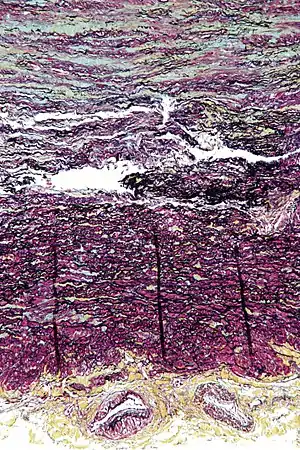Familial thoracic aortic aneurysm
Familial thoracic aortic aneurysm is an autosomal dominant[1] disorder of large arteries.
| Familial thoracic aortic aneurysm | |
|---|---|
| Other names | Familial aortic dissection, cystic medial necrosis of aorta[1] |
 | |
| Micrograph showing cystic medial degeneration, the histologic correlate of familial thoracic aortic aneurysms. The image shows abundant basophilic ground substance in the tunica media (blue at top of image) and disruption of the elastic fibers. The tunica adventitia (yellow at bottom of image) with vaso vasorum is also seen. Movat's stain. | |
There is an association between familial thoracic aortic aneurysm and Marfan syndrome as well as other hereditary connective tissue disorders.
Signs and symptoms
A degenerative breakdown of collagen, elastin, and smooth muscle caused by aging contributes to weakening of the wall of the artery.[2]
In the aorta, this can result in the formation of a fusiform aneurysm. There is also increased risk of aortic dissection.
Genetics
Types include:
| Type | OMIM | Gene | Locus |
|---|---|---|---|
| AAT1 | 607086 | 11q23.3-q24 | |
| AAT4 | 132900 | MYH11 | 16p |
| AAT6 | 611788 | ACTA2 | 10q |
Diagnosis
Terminology
It is sometimes called "Erdheim cystic medial necrosis of aorta", after Jakob Erdheim.[3][4]
The term "cystic medial degeneration" is sometimes used instead of "cystic medial necrosis", because necrosis is not always found.
References
- Online Mendelian Inheritance in Man (OMIM): 607086
- Wiesenfarth, John, http://www.emedicine.com/emerg/topic28.htm, October 4, 2005
- synd/2409 at Who Named It?
- J. Erdheim. Medionecrosis aortae idiopathica (cystica). Archiv für pathologische Anatomie und Physiologie und für klinische Medizin, 1929, 273: 454-479.
This article is issued from Wikipedia. The text is licensed under Creative Commons - Attribution - Sharealike. Additional terms may apply for the media files.